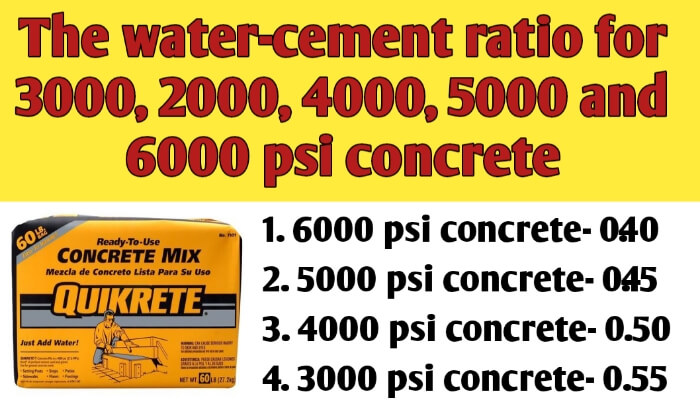The water-cement ratio for different grade of concrete varies depending on factors such as the desired strength, the type of cement, aggregates used, sand and environmental conditions like humidity and temperature. Typically for normal strength concrete, a water-cement ratio ranging from 0.4 to 0.6 is commonly used.
The water-cement ratio is a crucial factor in concrete mix design. It refers to the ratio of the mass of water to the mass of cement used in a concrete mix. It’s a critical parameter because it affects the workability, strength, durability, and permeability of concrete.

Generally, a lower water-cement ratio leads to higher strength and durability but may reduce workability. Conversely, a higher water-cement ratio increases workability but can decrease strength and durability. Balancing these factors is key to achieving the desired properties in concrete mixes.
In concrete terminology, concrete strength is measured in psi, which refers to the compressive strength of concrete measured in pounds per square inch (psi). Generally, the strength of concrete is 2000 psi, 2500 psi, 3000 psi, 3500 psi, 4000 psi, 4500 psi, 5000 psi and 6000 psi.
There are two types of concrete Non air-entrained concrete and air-entrained concrete which differ primarily in their resistance to freeze-thaw cycles and their ability to withstand exposure to harsh weather conditions. Non air-entrained concrete lacks microscopic air bubbles deliberately introduced during mixing, while air-entrained concrete contains tiny air bubbles distributed throughout the material.
However, a general guideline for various concrete strengths and their water-cement ratio is as follows:
- A typical water-cement ratio for 2000 psi concrete might range from 0.55 to 0.65.
- A typical water-cement ratio for 3000 psi concrete might range from 0.50 to 0.60.
- A typical water-cement ratio for 4000 psi concrete might range from 0.4 to 0.5.
- A typical water-cement ratio for 5000 psi concrete might range from 0.35 to 0.45.
- A typical water-cement ratio for 6000 psi concrete might range from 0.3 to 0.4.
The water-cement ratio can vary depending on factors such as the type of cement, admixtures used, and the specific requirements of the project. However, you will need 32 to 39 gallons of water per cubic yard of concrete.
To produce one cubic yard of 3,000 psi concrete, you need to mix 5 94lb bags of Portland cement, 15 cubic feet of sand, 15 cubic feet of gravel and 31 gallons of water.
To produce one cubic yard of 4,000 psi concrete, you need to mix 6 94lb bags of Portland cement, 12 cubic feet of sand, 18 cubic feet of gravel and 34 gallons of water.
To produce one cubic yard of 5,000 psi concrete, you need to mix 7 94lb bags of Portland cement, 14 cubic feet of sand, 14 cubic feet of gravel and 36 gallons of water.
Standard ready-mix concrete includes: 5 bag mix (3000 psi), 5.5 bag mix (3500 psi), 6 bag mix (4000 psi), 6.5 bag mix (4500 psi), 7 bag mix (5000 psi), and 8 bag mix (6000 psi).
Here’s are table for the water-cement ratio by weight for non air-entrained & air-entrained concrete:-
| Compressive strength at 28 days in PSI | Water cement ratio by weight | |
| Non air entrained concrete | Air entrained concrete | |
| 6000 PSI | 0.41 | 0.32 |
| 5000 PSI | 0.48 | 0.40 |
| 4000 PSI | 0.57 | 0.48 |
| 3000 PSI | 0.68 | 0.59 |
| 2000 PSI | 0.82 | 0.74 |
Conclusions:
In general, the water-cement ratio for residential application should be 0.60 for the 2000 psi concrete, 0.55 for the 3000 psi concrete, 0.5 for the 4000 psi concrete, 0.45 for the 5000 psi concrete, and 0.40 for the 6000 psi concrete.